Changes in Service and Associated Ridership Impacts near a New Light Rail Transit Line
Abstract
:1. Introduction
2. Literature Review
3. Ridership and Service Changes
3.1. Overview of the Expo and Gold LRT Lines
3.1.1. Expo Line
3.1.2. Gold Line and Gold Line Extension
3.2. Bus Ridership Change after LRT Opening/Extension
3.2.1. Expo Line
3.2.2. Gold Line
3.3. Service Change after LRT Opening/Extension
4. Conclusions and Policy Implications
Acknowledgments
Author Contributions
Conflicts of Interest
Appendix A. Detailed Ridership Data for Expo and Gold Lines
| Line # | July 2011 | August 2011 | September 2011 | October 2011 | November 2011 | July 2012 | August 2012 | September 2012 | October 2012 | November 2012 | July–November 2011 | July–November 2012 | Average Difference | Difference (%) | |
|---|---|---|---|---|---|---|---|---|---|---|---|---|---|---|---|
| Local through CBD | 2 | 19,417 | 18,868 | 20,324 | 20,380 | 19,523 | 19,249 | 19,838 | 20,515 | 20,779 | 19,345 | 19,702 | 19,945 | 243 | 1.2% |
| 4 | 20,582 | 20,294 | 21,573 | 21,645 | 21,315 | 20,963 | 22,200 | 22,388 | 22,254 | 21,036 | 21,082 | 21,768 | 686 | 3.3% | |
| 10 | 11,994 | 11,785 | 13,914 | 13,868 | 13,295 | 11,463 | 12,924 | 13,919 | 13,959 | 12,890 | 12,971 | 13,031 | 60 | 0.5% | |
| 14 | 19,166 | 19,476 | 21,919 | 22,112 | 21,458 | 19,040 | 20,595 | 22,244 | 22,376 | 20,498 | 20,826 | 20,951 | 124 | 0.6% | |
| 16 | 25,509 | 25,214 | 26,739 | 27,103 | 26,924 | 24,415 | 25,506 | 25,995 | 26,082 | 25,089 | 26,298 | 25,417 | −880 | −3.3% | |
| 18 | 24,678 | 24,314 | 25,695 | 25,528 | 24,901 | 23,654 | 24,554 | 24,821 | 24,827 | 23,996 | 25,023 | 24,370 | −653 | −2.6% | |
| 20 | 17,161 | 17,177 | 17,558 | 17,409 | 16,792 | 17,215 | 17,684 | 17,773 | 17,791 | 16,654 | 17,219 | 17,423 | 204 | 1.2% | |
| 28 | 7902 | 7784 | 8148 | 8047 | 7942 | 8535 | 8571 | 8793 | 8834 | 8371 | 7965 | 8621 | 656 | 8.2% | |
| 30 | 13,045 | 13,090 | 13,237 | 13,048 | 12,868 | 18,511 | 18,703 | 19,317 | 19,377 | 18,337 | 13,058 | 18,849 | 5791 | 44.4% | |
| 33 | 12,418 | 12,173 | 12,906 | 12,700 | 12,586 | 12,744 | 13,546 | 13,727 | 13,686 | 12,874 | 12,557 | 13,315 | 759 | 6.0% | |
| 35 | 12,050 | 11,872 | 13,627 | 13,441 | 13,279 | 10,655 | 11,655 | 12,877 | 12,932 | 12,004 | 12,854 | 12,025 | −829 | −6.5% | |
| 40 | 24,022 | 23,790 | 25,133 | 25,254 | 25,126 | 22,546 | 23,521 | 24,408 | 24,010 | 22,728 | 24,665 | 23,443 | −1222 | −5.0% | |
| 45 | 21,908 | 21,668 | 22,901 | 22,641 | 22,366 | 20,296 | 21,107 | 22,026 | 22,207 | 21,126 | 22,297 | 21,352 | −944 | −4.2% | |
| 51 | 27,074 | 27,606 | 29,068 | 28,905 | 28,639 | 27,509 | 28,459 | 29,517 | 30,080 | 28,743 | 28,258 | 28,862 | 603 | 2.1% | |
| 53 | 13,342 | 13,299 | 14,623 | 14,536 | 14,338 | 13,408 | 14,102 | 15,122 | 15,300 | 14,339 | 14,028 | 14,454 | 427 | 3.0% | |
| 55 | 9094 | 9034 | 10,270 | 10,308 | 9934 | 8501 | 9520 | 10,682 | 10,657 | 9759 | 9728 | 9824 | 96 | 1.0% | |
| 60 | 19,809 | 19,864 | 20,749 | 20,252 | 19,992 | 20,093 | 20,918 | 21,163 | 21,610 | 20,767 | 20,133 | 20,910 | 777 | 3.9% | |
| 62 | 4851 | 5041 | 5190 | 5103 | 5076 | 5056 | 5189 | 5339 | 5380 | 5113 | 5052 | 5215 | 163 | 3.2% | |
| 66 | 19,684 | 19,314 | 19,516 | 19,442 | 19,246 | 18,394 | 18,765 | 18,828 | 18,782 | 17,812 | 19,440 | 18,516 | −924 | −4.8% | |
| 70 | 12,368 | 12,341 | 12,731 | 12,606 | 12,443 | 12,371 | 12,443 | 12,916 | 13,064 | 12,229 | 12,498 | 12,605 | 107 | 0.9% | |
| 71 | 1663 | 1670 | 1879 | 2037 | 2010 | 1839 | 1959 | 2128 | 2284 | 2113 | 1852 | 2065 | 213 | 11.5% | |
| 76 | 10,829 | 10,711 | 11,231 | 11,078 | 10,963 | 10,429 | 10,206 | 10,740 | 10,690 | 10,174 | 10,962 | 10,448 | −515 | −4.7% | |
| 78 | 11,573 | 11,465 | 12,113 | 11,885 | 11,710 | 11,690 | 11,767 | 12,425 | 12,515 | 12,053 | 11,749 | 12,090 | 341 | 2.9% | |
| 81 | 15,870 | 15,987 | 17,357 | 17,161 | 16,757 | 15,374 | 16,112 | 17,336 | 17,276 | 16,543 | 16,626 | 16,528 | −98 | −0.6% | |
| 83 | 4034 | 3918 | 4189 | 4107 | 3996 | 3368 | 3406 | 3514 | 3581 | 3306 | 4049 | 3435 | −614 | −15.2% | |
| 84 | 9182 | 8612 | 9691 | 9524 | 9360 | 8559 | 8730 | 9565 | 9593 | 8963 | 9274 | 9082 | −192 | −2.1% | |
| 90 | 5911 | 6113 | 6982 | 6772 | 6626 | 6406 | 6478 | 7791 | 7589 | 7084 | 6481 | 7070 | 589 | 9.1% | |
| 92 | 5771 | 5661 | 5855 | 5827 | 5916 | 5468 | 5525 | 5714 | 5747 | 5597 | 5806 | 5610 | −196 | −3.4% | |
| 94 | 6644 | 6517 | 6669 | 6553 | 6522 | 6221 | 6242 | 6545 | 6492 | 6142 | 6581 | 6328 | −253 | −3.8% | |
| 96 | 1631 | 1607 | 1651 | 1628 | 1516 | 1676 | 2030 | 1743 | 1690 | 1533 | 1607 | 1734 | 128 | 8.0% | |
| Local through non-CBD | 102 | 1556 | 1590 | 1752 | 1685 | 1579 | 2274 | 2442 | 2609 | 2605 | 2532 | 1632 | 2492 | 860 | 52.7% |
| 105 | 11,668 | 11,833 | 12,746 | 12,557 | 12,850 | 12,496 | 13,265 | 13,569 | 13,725 | 13,032 | 12,331 | 13,217 | 887 | 7.2% | |
| 200 | 14,790 | 14,846 | 15,714 | 15,752 | 15,231 | 15,170 | 15,852 | 16,235 | 16,063 | 15,405 | 15,267 | 15,745 | 478 | 3.1% | |
| 204 | 26,770 | 26,616 | 29,340 | 29,259 | 28,810 | 25,772 | 27,904 | 29,287 | 28,949 | 26,899 | 28,159 | 27,762 | −397 | −1.4% | |
| 206 | 12,940 | 12,738 | 14,083 | 14,149 | 13,688 | 12,951 | 13,767 | 14,341 | 14,057 | 13,289 | 13,520 | 13,681 | 161 | 1.2% | |
| 207 | 23,766 | 22,945 | 24,847 | 24,093 | 23,455 | 21,491 | 22,855 | 23,738 | 23,252 | 21,761 | 23,821 | 22,619 | −1202 | −5.0% | |
| 209 | 850 | 875 | 1040 | 1049 | 1033 | 895 | 1034 | 1177 | 1173 | 1044 | 969 | 1065 | 95 | 9.8% | |
| 210 | 14,576 | 14,359 | 15,931 | 15,404 | 14,897 | 14,772 | 15,398 | 16,840 | 16,942 | 15,967 | 15,033 | 15,984 | 950 | 6.3% | |
| 212 | 13,132 | 13,249 | 14,181 | 14,395 | 14,125 | 14,303 | 14,935 | 15,492 | 15,402 | 14,645 | 13,816 | 14,955 | 1139 | 8.2% | |
| 217 | 8063 | 8132 | 8336 | 7994 | 8022 | 8545 | 8889 | 9066 | 9160 | 8699 | 8109 | 8872 | 762 | 9.4% | |
| 220 | 289 | 267 | 269 | 252 | 264 | 280 | 301 | 295 | 307 | 273 | 268 | 291 | 23 | 8.6% | |
| Limited Express | 305 | 2606 | 2580 | 2762 | 2651 | 2775 | 2675 | ||||||||
| 439 | 428 | 443 | 470 | 453 | 429 | 445 | |||||||||
| 442 | 228 | 241 | 268 | 277 | 256 | 249 | 252 | 274 | 283 | 281 | 254 | 268 | 14 | 5.4% | |
| 450 | 1389 | 1396 | 1495 | 1567 | 1545 | 1635 | 1618 | 1704 | 1771 | 1723 | 1478 | 1690 | 212 | 14.3% | |
| 460 | 4586 | 4683 | 4620 | 4528 | 4432 | 4862 | 4874 | 4950 | 4896 | 4637 | 4570 | 4844 | 274 | 6.0% | |
| 487 | 3825 | 3779 | 4103 | 4285 | 4092 | 3840 | 3798 | 4198 | 4437 | 3982 | 4017 | 4051 | 34 | 0.9% | |
| 534 | 3002 | 3015 | 3114 | 2975 | 2908 | 2853 | 3005 | 3094 | 3032 | 2873 | 3003 | 2971 | −31 | −1.0% | |
| 550 | 3176 | 3136 | 3316 | 3289 | 3190 | 1618 | 1664 | 1789 | 1747 | 1655 | 3221 | 1695 | −1527 | −47.4% | |
| Shuttle | 603 | 6555 | 6455 | 7014 | 6921 | 7111 | 6403 | 7330 | 7435 | 7279 | 6764 | 6811 | 7042 | 231 | 3.4% |
| 607 | 42 | 43 | 50 | 51 | 61 | 63 | 52 | 75 | 67 | 66 | 49 | 65 | 15 | 30.8% | |
| Rapid | 705 | 7561 | 7741 | 8519 | 8418 | 8208 | 7347 | 7626 | 8099 | 8241 | 7892 | 8089 | 7841 | −248 | −3.1% |
| 710 | 6977 | 6930 | 8155 | 8044 | 7905 | 7179 | 7605 | 8846 | 8873 | 8428 | 7602 | 8186 | 584 | 7.7% | |
| 720 | 41,601 | 41,215 | 41,800 | 41,098 | 40,115 | 42,240 | 42,819 | 42,728 | 42,108 | 40,014 | 41,166 | 41,982 | 816 | 2.0% | |
| 728 | 6747 | 6563 | 6833 | 6723 | 6551 | 5724 | 5771 | 6102 | 6236 | 6009 | 6683 | 5968 | −715 | −10.7% | |
| 730 | 4695 | 4606 | 4800 | 4644 | 4673 | 4684 | |||||||||
| 733 | 13,119 | 12,621 | 13,146 | 12,975 | 12,507 | 12,085 | 12,730 | 12,861 | 12,885 | 11,785 | 12,874 | 12,469 | −404 | −3.1% | |
| 740 | 7520 | 7541 | 8097 | 8073 | 7894 | 3643 | 3868 | 4270 | 4368 | 4175 | 7825 | 4065 | −3760 | −48.1% | |
| 745 | 6843 | 6727 | 7316 | 7302 | 7172 | 6430 | 6615 | 6923 | 7080 | 6736 | 7072 | 6757 | −315 | −4.5% | |
| 754 | 20,304 | 20,137 | 22,390 | 22,271 | 21,793 | 20,049 | 20,890 | 22,263 | 22,468 | 21,108 | 21,379 | 21,356 | −23 | −0.1% | |
| 757 | 12,527 | 12,730 | 13,702 | 13,700 | 13,754 | 12,897 | 13,486 | 14,497 | 14,861 | 13,829 | 13,283 | 13,914 | 631 | 4.8% | |
| 760 | 6486 | 6594 | 6855 | 6723 | 6589 | 5816 | 6082 | 6304 | 6198 | 5978 | 6649 | 6076 | −574 | −8.6% | |
| 770 | 8786 | 8554 | 9207 | 9037 | 8982 | 8527 | 8405 | 9188 | 9292 | 8836 | 8913 | 8850 | −64 | −0.7% | |
| 780 | 9854 | 9534 | 10,837 | 10,881 | 10,614 | 10,100 | 10,246 | 11,266 | 11,425 | 10,495 | 10,344 | 10,706 | 362 | 3.5% | |
| 794 | 4953 | 5105 | 5438 | 5462 | 5144 | 5120 | 5334 | 5421 | 5598 | 5480 | 5220 | 5391 | 170 | 3.3% | |
| 910 | 9480 | 9730 | 10,414 | 11,234 | 10,648 | 11,206 | 11,449 | 12,197 | 13,765 | 13,515 | 10,301 | 12,426 | 2125 | 20.6% | |
| EXPO | 806 | 18,181 | 19,776 | 20,656 | 21,382 | 22,066 | |||||||||
| Buses | 730,872 | 725,814 | 776,398 | 771,071 | 756,721 | 714,483 | 744,416 | 777,004 | 779,989 | 737,025 | 752,175 | 750,583 | −1592 | −0.2% | |
| Total | 730,872 | 725,814 | 776,398 | 771,071 | 756,721 | 732,664 | 764,192 | 797,660 | 801,371 | 759,091 | 752,175 | 770,996 | 18,820 | 2.5% | |
| Line # | July 2009 | August 2009 | September 2009 | October 2009 | July 2010 | August 2010 | September 2010 | October 2010 | July–October 2009 | July–October 2010 | Average Difference | Difference (%) | |
|---|---|---|---|---|---|---|---|---|---|---|---|---|---|
| Local through CBD | 2 | 22,080 | 21,620 | 22,595 | 22,626 | 19,656 | 20,105 | 20,348 | 20,654 | 22,230 | 20,191 | −2040 | −9.2% |
| 4 | 20,630 | 20,404 | 21,651 | 21,418 | 19,375 | 19,031 | 19,548 | 19,313 | 21,026 | 19,317 | −1709 | −8.1% | |
| 10 | 12,902 | 12,810 | 14,567 | 14,387 | 11,934 | 11,666 | 13,302 | 13,060 | 13,667 | 12,491 | −1176 | −8.6% | |
| 14 | 16,346 | 16,187 | 18,158 | 18,285 | 16,477 | 16,251 | 17,561 | 17,322 | 17,244 | 16,903 | −341 | −2.0% | |
| 16 | 26,511 | 26,311 | 27,332 | 27,485 | 25,169 | 24,974 | 26,101 | 26,248 | 26,910 | 25,623 | −1287 | −4.8% | |
| 18 | 26,783 | 26,533 | 27,869 | 27,740 | 24,853 | 24,581 | 25,590 | 25,192 | 27,231 | 25,054 | −2177 | −8.0% | |
| 20 | 17,569 | 17,550 | 18,128 | 17,794 | 16,789 | 16,689 | 16,812 | 17,036 | 17,760 | 16,832 | −929 | −5.2% | |
| 26 | 27,413 | 27,259 | 28,363 | 28,777 | 27,744 | 27,495 | 28,450 | 28,167 | 27,953 | 27,964 | 11 | 0.0% | |
| 28 | 9470 | 9581 | 9545 | 9520 | 8400 | 8092 | 8317 | 8656 | 9529 | 8366 | −1163 | −12.2% | |
| 30 | 16,898 | 16,565 | 16,574 | 16,202 | 13,221 | 12,843 | 13,042 | 12,913 | 16,560 | 13,005 | −3555 | −21.5% | |
| 33 | 23,214 | 22,931 | 23,475 | 22,922 | 11,637 | 11,299 | 11,430 | 11,396 | 23,136 | 11,441 | −11,695 | −50.6% | |
| 35 | 8853 | 8503 | 9911 | 10,011 | 7919 | 7857 | 9008 | 9085 | 9320 | 8467 | −852 | −9.1% | |
| 38 | 5779 | 5758 | 6460 | 6476 | 5459 | 5393 | 6092 | 5887 | 6118 | 5708 | −411 | −6.7% | |
| 40 | 17,677 | 17,344 | 18,409 | 18,449 | 17,551 | 17,038 | 17,722 | 17,115 | 17,970 | 17,357 | −613 | −3.4% | |
| 42 | 4859 | 4703 | 5120 | 5122 | 4589 | 4529 | 4755 | 4813 | 4951 | 4672 | −280 | −5.6% | |
| 45 | 20,841 | 20,594 | 21,751 | 21,351 | 20,922 | 20,728 | 21,883 | 21,530 | 21,134 | 21,266 | 132 | 0.6% | |
| 53 | 10,389 | 10,348 | 11,226 | 10,922 | 10,603 | 10,423 | 10,970 | 10,914 | 10,721 | 10,728 | 6 | 0.1% | |
| 55 | 10,358 | 9827 | 11,265 | 11,454 | 9487 | 9538 | 10,411 | 10,340 | 10,726 | 9944 | −782 | −7.3% | |
| 60 | 17,642 | 17,585 | 17,704 | 17,767 | 18,096 | 18,094 | 18,163 | 17,649 | 17,675 | 18,001 | 326 | 1.8% | |
| 62 | 4244 | 4367 | 4404 | 4472 | 4647 | 4727 | 4874 | 4724 | 4372 | 4743 | 371 | 8.5% | |
| 66 | 23,231 | 23,285 | 23,489 | 23,489 | 20,769 | 20,518 | 20,617 | 20,429 | 23,374 | 20,583 | −2790 | −11.9% | |
| 70 | 13,301 | 13,365 | 13,916 | 13,743 | 11,922 | 11,781 | 12,215 | 11,693 | 13,581 | 11,903 | −1679 | −12.4% | |
| 76 | 10,679 | 10,553 | 11,047 | 10,894 | 10,439 | 10,387 | 10,884 | 10,708 | 10,793 | 10,605 | −189 | −1.7% | |
| 78 | 11,457 | 11,402 | 11,806 | 11,589 | 11,341 | 11,241 | 11,777 | 11,345 | 11,564 | 11,426 | −138 | −1.2% | |
| 81 | 16,903 | 16,727 | 17,815 | 17,742 | 15,961 | 15,859 | 16,903 | 16,816 | 17,297 | 16,385 | −912 | −5.3% | |
| 83 | 5710 | 5548 | 5958 | 5965 | 4770 | 4618 | 4952 | 4862 | 5795 | 4801 | −995 | −17.2% | |
| 84 | 9222 | 9119 | 10,181 | 9834 | 8777 | 8329 | 9121 | 9100 | 9589 | 8832 | −757 | −7.9% | |
| 90 | 6034 | 6011 | 6541 | 6496 | 5883 | 5753 | 6579 | 6225 | 6271 | 6110 | −161 | −2.6% | |
| 92 | 5675 | 5720 | 5966 | 5989 | 5783 | 5767 | 5890 | 5764 | 5838 | 5801 | −37 | −0.6% | |
| 94 | 6837 | 6849 | 6987 | 6924 | 6135 | 6105 | 6314 | 6108 | 6899 | 6166 | −734 | −10.6% | |
| 96 | 2407 | 2389 | 2339 | 2098 | 2334 | 2307 | 2501 | 2455 | 2308 | 2399 | 91 | 3.9% | |
| Local through non-CBD | 251 | 10,073 | 10,064 | 10,294 | 10,123 | 9631 | 9691 | 9781 | 9378 | 10,139 | 9620 | −518 | −5.1% |
| 252 | 2786 | 2590 | 3274 | 3231 | 2722 | 2817 | 3025 | 3210 | 2970 | 2944 | −27 | −0.9% | |
| 254 | 599 | 662 | 727 | 691 | 725 | 715 | 759 | 763 | 670 | 741 | 71 | 10.6% | |
| 256 | 1497 | 1384 | 2038 | 1735 | 1426 | 1359 | 1667 | 1658 | 1664 | 1528 | −136 | −8.2% | |
| 258 | 1612 | 1651 | 1776 | 1730 | 1499 | 1542 | 1689 | 1626 | 1692 | 1589 | −103 | −6.1% | |
| 260 | 11,447 | 11,264 | 12,475 | 12,185 | 11,688 | 11,616 | 12,951 | 12,629 | 11,843 | 12,221 | 378 | 3.2% | |
| 287 | 1775 | 1751 | 1875 | 1900 | 1976 | 1926 | 2008 | 1923 | 1825 | 1958 | 133 | 7.3% | |
| Limited Express | 439 | 914 | 972 | 971 | 1006 | 1111 | 1095 | 1144 | 1105 | 966 | 1114 | 148 | 15.3% |
| 442 | 209 | 209 | 240 | 242 | 205 | 214 | 219 | 237 | 225 | 219 | −6 | −2.8% | |
| 444 | 2982 | 3008 | 3026 | 3024 | 3010 | −3010 | |||||||
| 445 | 1314 | 1339 | 1361 | 1380 | 1200 | 1173 | 1226 | 1228 | 1349 | 1207 | −142 | −10.5% | |
| 446 | 4122 | 4023 | 4324 | 4386 | 4214 | −4214 | |||||||
| 460 | 4238 | 4412 | 4367 | 4171 | 4516 | 4375 | 4323 | 4172 | 4297 | 4347 | 50 | 1.2% | |
| 484 | 6975 | 7021 | 7415 | 7884 | 7324 | −7324 | |||||||
| 485 | 2931 | 2818 | 3042 | 3283 | 2447 | 2270 | 2541 | 2810 | 3019 | 2517 | −502 | −16.6% | |
| 487 | 3862 | 3743 | 4179 | 4185 | 3553 | 3461 | 3856 | 3869 | 3992 | 3685 | −308 | −7.7% | |
| 490 | 5548 | 5690 | 6283 | 6517 | 6010 | −6010 | |||||||
| Shuttle | 605 | 2339 | 2371 | 2847 | 2533 | 1998 | 1950 | 2376 | 2378 | 2523 | 2176 | −347 | −13.8% |
| 620 | 646 | 657 | 761 | 774 | 731 | 716 | 709 | 740 | 710 | 724 | 15 | 2.0% | |
| 665 | 813 | 789 | 949 | 1025 | 711 | 674 | 791 | 844 | 894 | 755 | −139 | −15.5% | |
| Rapid | 704 | 12,479 | 12,384 | 13,311 | 12,628 | 12,171 | 12,071 | 12,818 | 12,798 | 12,701 | 12,465 | −236 | −1.9% |
| 714 | 3866 | 3729 | 4206 | 4197 | 3207 | 3224 | 3502 | 3541 | 4000 | 3369 | −631 | −15.8% | |
| 720 | 38,405 | 38,367 | 38,370 | 37,141 | 37,787 | 37,798 | 38,003 | 36,898 | 38,071 | 37,622 | −449 | −1.2% | |
| 728 | 8428 | 8562 | 8873 | 8611 | 8124 | 7900 | 8267 | 8323 | 8619 | 8154 | −465 | −5.4% | |
| 730 | 4951 | 4900 | 5458 | 5262 | 4814 | 4558 | 4914 | 5031 | 5143 | 4829 | −314 | −6.1% | |
| 740 | 9110 | 9039 | 9656 | 9705 | 8570 | 8404 | 8890 | 8640 | 9378 | 8626 | −752 | −8.0% | |
| 745 | 7935 | 8003 | 8229 | 8288 | 7126 | 6974 | 7523 | 7422 | 8114 | 7261 | −853 | −10.5% | |
| 751 | 5967 | 6229 | 6350 | 6335 | 6256 | 6060 | 6395 | 6068 | 6220 | 6195 | −26 | −0.4% | |
| 753 | 3149 | 3042 | 3166 | 3320 | 2877 | 2844 | 2820 | 2840 | 3169 | 2845 | −324 | −10.2% | |
| 760 | 8513 | 8536 | 8952 | 8764 | 8716 | 8754 | 8831 | 8619 | 8691 | 8730 | 39 | 0.4% | |
| 762 | 5267 | 5251 | 6257 | 6165 | 4954 | 4647 | 5447 | 5274 | 5735 | 5081 | −655 | −11.4% | |
| 770 | 9217 | 9151 | 10,134 | 10,153 | 9068 | 8718 | 9344 | 9188 | 9664 | 9080 | −584 | −6.0% | |
| 794 | 6084 | 6387 | 6432 | 6442 | 5518 | 5676 | 5829 | 5643 | 6336 | 5667 | −670 | −10.6% | |
| GOLD | 804 | 21,065 | 24,175 | 22,476 | 21,322 | 34,285 | 35,247 | 35,649 | 34,440 | 22,260 | 34,905 | 12,646 | 56.8% |
| Buses | 621,967 | 617,746 | 652,170 | 646,959 | 563,969 | 557,240 | 583,780 | 576,374 | 634,711 | 570,341 | −64,370 | −10.1% | |
| Total | 643,032 | 641,921 | 674,646 | 668,281 | 598,254 | 592,487 | 619,429 | 610,814 | 656,970 | 605,246 | −51,724 | −7.9% | |
References
- Southern California Association of Governments (SCAG). The 2016–2040 Regional Transportation Plan/Sustainable Communities Strategy. Available online: http://scagrtpscs.net/Pages/FINAL2016RTPSCS.aspx (accessed on 9 October 2017).
- Baxandall, P.; Dutzik, T.; Hoen, J. A Better Way to Go: Meeting America’s 21st Century Transportation Challenges with Modern Public Transit; US PIRG: Boston, MA, USA, 2008. [Google Scholar]
- Black, W.R. Sustainable transportation: A US perspective. J. Transp. Geogr. 1996, 4, 151–159. [Google Scholar] [CrossRef]
- Shiftan, Y.; Kaplan, S.; Hakkert, S. Scenario building as a tool for planning a sustainable transportation system. Transp. Res. Part D 2003, 8, 323–342. [Google Scholar] [CrossRef]
- Kennedy, C.; Miller, E.; Shalaby, A.; Maclean, H.; Coleman, J. The four pillars of sustainable urban transportation. Transp. Rev. 2005, 25, 393–414. [Google Scholar] [CrossRef]
- Boschmann, E.E.; Kwan, M.P. Toward socially sustainable urban transportation: Progress and potentials. Int. J. Sustain. Transp. 2008, 2, 138–157. [Google Scholar] [CrossRef]
- May, A.D. Urban transport and sustainability: The key challenges. Int. J. Sustain. Transp. 2013, 7, 170–185. [Google Scholar] [CrossRef]
- Henao, A.; Piatkowski, D.; Luckey, K.S.; Nordback, K.; Marshall, W.E.; Krizek, K.J. Sustainable transportation infrastructure investments and mode share changes: A 20-year background of Boulder, Colorado. Transp. Policy 2015, 37, 64–71. [Google Scholar] [CrossRef]
- Un-Habitat. Planning and Design for Sustainable Urban Mobility: Global Report on Human Settlements. 2013. Available online: https://unhabitat.org/wp-content/uploads/2013/06/GRHS.2013.03.pdf (accessed on 28 September 2017).
- Werner, C.M.; Brown, B.B.; Tribby, C.P.; Tharp, D.; Flick, K.; Miller, H.J.; Smith, K.R.; Jensen, W. Evaluating the attractiveness of a new light rail extension: Testing simple change and displacement change hypotheses. Transp. Policy 2016, 45, 15–23. [Google Scholar] [CrossRef] [PubMed]
- Moore, J.E. Ridership and cost on the long Beach-Los Angeles blue line train. Transp. Res. Part A Policy Pract. 1993, 27, 139–152. [Google Scholar] [CrossRef]
- Chakrabarti, S. How can public transit get people out of their cars? An analysis of transit mode choice for commute trips in Los Angeles. Transp. Policy 2017, 54, 80–89. [Google Scholar] [CrossRef]
- Nelson, L.J. The Metro Can Take You Farther Than Ever. Here’s Why Ridership Dropped—Again. Available online: http://www.latimes.com/local/lanow/la-me-ln-2016-metro-ridership-decline-20170209-story.html (accessed on 9 October 2017).
- Los Angeles County Metropolitan Transportation Authority. Metro Ridership. Available online: http://isotp.metro.net/MetroRidership/Index.aspx (accessed on 1 September 2017).
- Romann, E. Transit Civil Rights and Economic Survival in Los Angeles: A Case for Federal Intervention in LA Metro. Available online: http://www.thestrategycenter.org/sites/www.thestrategycenter.org/files/MTA_civil_rights_report_11-11-11.pdf (accessed on 10 October 2017).
- Gomez-Ibanez, J.A. A dark side to light rail? The experience of three new transit systems. J. Am. Plan. Assoc. 1985, 51, 337–351. [Google Scholar]
- Allen, D.; Hufstedler, G. Bus-and-rail and all-bus transit systems: Experience in Dallas and Houston, Texas, 1985 to 2003. Transp. Res. Rec. J. Transp. Res. Board 2006, 1986, 127–136. [Google Scholar] [CrossRef]
- Gomez-Ibanez, J.A. Big-city transit rider snip, deficits, and politics: Avoiding reality in Boston. J. Am. Plan. Assoc. 1996, 62, 30–50. [Google Scholar] [CrossRef]
- Kain, J.; Liu, Z. Ridership Models for San Diego and Houston: Prepared for the Federal Transit Administration; US Department of Transportation: Washington, WA, USA, 1995.
- Syed, S.J.; Khan, A.M. Factor analysis for the study of determinants of public transit ridership. J. Public Transp. 2000, 3, 1–17. [Google Scholar]
- Kim, D.; Ahn, Y.; Choi, S.; Kim, K. Sustainable mobility: Longitudinal analysis of built environment on transit ridership. Sustainability 2016, 8, 1016. [Google Scholar] [CrossRef]
- Ding, C.; Wang, D.; Ma, X.; Li, H. Predicting short-term subway ridership and prioritizing its influential factors using gradient boosting decision trees. Sustainability 2016, 8, 1100. [Google Scholar] [CrossRef]
- Stanley, R. Continuing Examination of Successful Transit Ridership Initiatives; TCRP Research Results Digest: Washington, DC, USA, 1998. [Google Scholar]
- Yoh, A.; Haas, P.; Taylor, B. Understanding transit ridership growth: Case studies of successful transit systems in the 1990s. Transp. Res. Rec. J. Transp. Res. Board 2003, 1835, 111–120. [Google Scholar] [CrossRef]
- Hickey, R. Impact of transit fare increase on ridership and revenue: Metropolitan transportation authority, New York city. Transp. Res. Rec. J. Transp. Res. Board 2005, 1927, 239–248. [Google Scholar] [CrossRef]
- Zhang, J.; Yan, X.; An, M.; Sun, L. The impact of Beijing subway’s new fare policy on riders’ attitude, travel pattern and demand. Sustainability 2017, 9, 689. [Google Scholar] [CrossRef]
- Li, M.; Dong, L.; Shen, Z.; Lang, W.; Ye, X. Examining the interaction of taxi and subway ridership for sustainable urbanization. Sustainability 2017, 9, 242. [Google Scholar] [CrossRef]
- Zhang, D.; Wang, X.C. Transit ridership estimation with network Kriging: A case study of Second Avenue Subway, NYC. J. Transp. Geogr. 2014, 41, 107–115. [Google Scholar] [CrossRef]
- Los Angeles County Metropolitan Transportation Authority. Maps and Timetables. Available online: http://www.metro.net/riding/maps/ (accessed on 1 September 2017).
- Newton, D.; Linton, J. Do Gas Prices Impact Transit Ridership? Sure. But There’s More. Available online: http://cal.streetsblog.org/2015/10/28/do-gas-prices-impact-transit-ridership-sure-but-theres-more/ (accessed on 5 December 2015).
- Federal Transit Administration. Before-And-After Studies of New Starts Projects. Available online: https://www.transit.dot.gov/sites/fta.dot.gov/files/docs/FY2013_Before_and_After_Studies_Report_to_Congress_Final.pdf (accessed on 18 August 2016).
- Chester, M.; Pincetl, S.; Elizabeth, Z.; Eisenstein, W.; Matute, J. Infrastructure and automobile shifts: Positioning transit to reduce life-cycle environmental impacts for urban sustainability goals. Environ. Res. Lett. 2013, 8, 1–10. [Google Scholar] [CrossRef]
- Nelson, L.J.; Reyes, E.A. Metro Agrees to Buy 95 Electric Buses, in the First Step toward an Emissions-Free Fleet. Available online: http://www.latimes.com/local/lanow/la-me-ln-metro-electric-buses-20170727-story.html (accessed on 18 August 2016).
- Cao, X.J.; Schoner, J. The influence of light rail transit on transit use: An exploration of station area residents along the Hiawatha line in Minneapolis. Transp. Res. Part A Policy Pract. 2014, 59, 134–143. [Google Scholar] [CrossRef]
- Spears, S.; Boarnet, M.G.; Houston, D. Driving reduction after the introduction of light rail transit: Evidence from an experimental-control group evaluation of the Los Angeles Expo Line. Urban Stud. 2017, 54, 2780–2799. [Google Scholar] [CrossRef]
- Lane, B.W. The relationship between recent gasoline price fluctuations and transit ridership in major US cities. J. Transp. Geogr. 2010, 18, 214–225. [Google Scholar] [CrossRef]
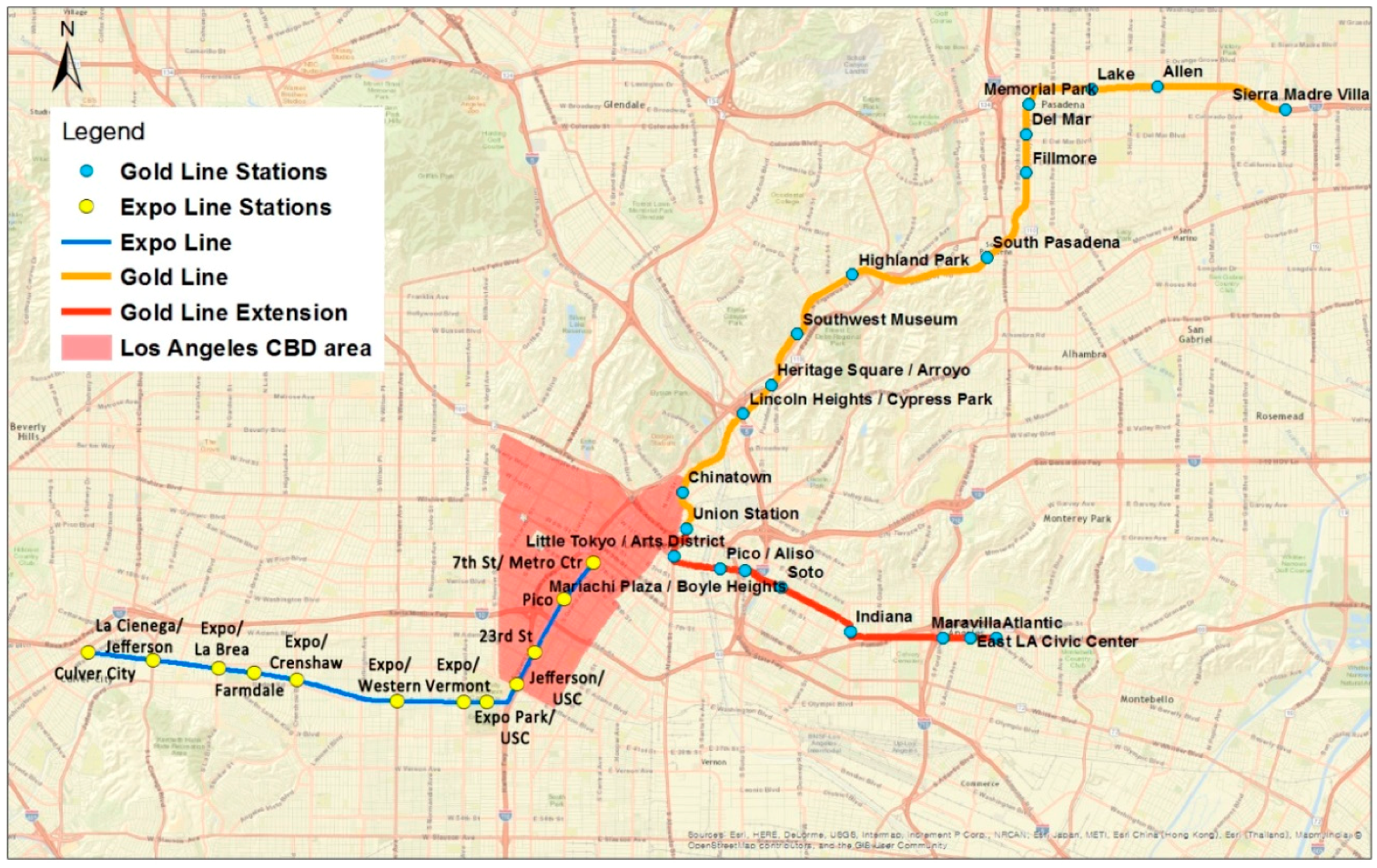
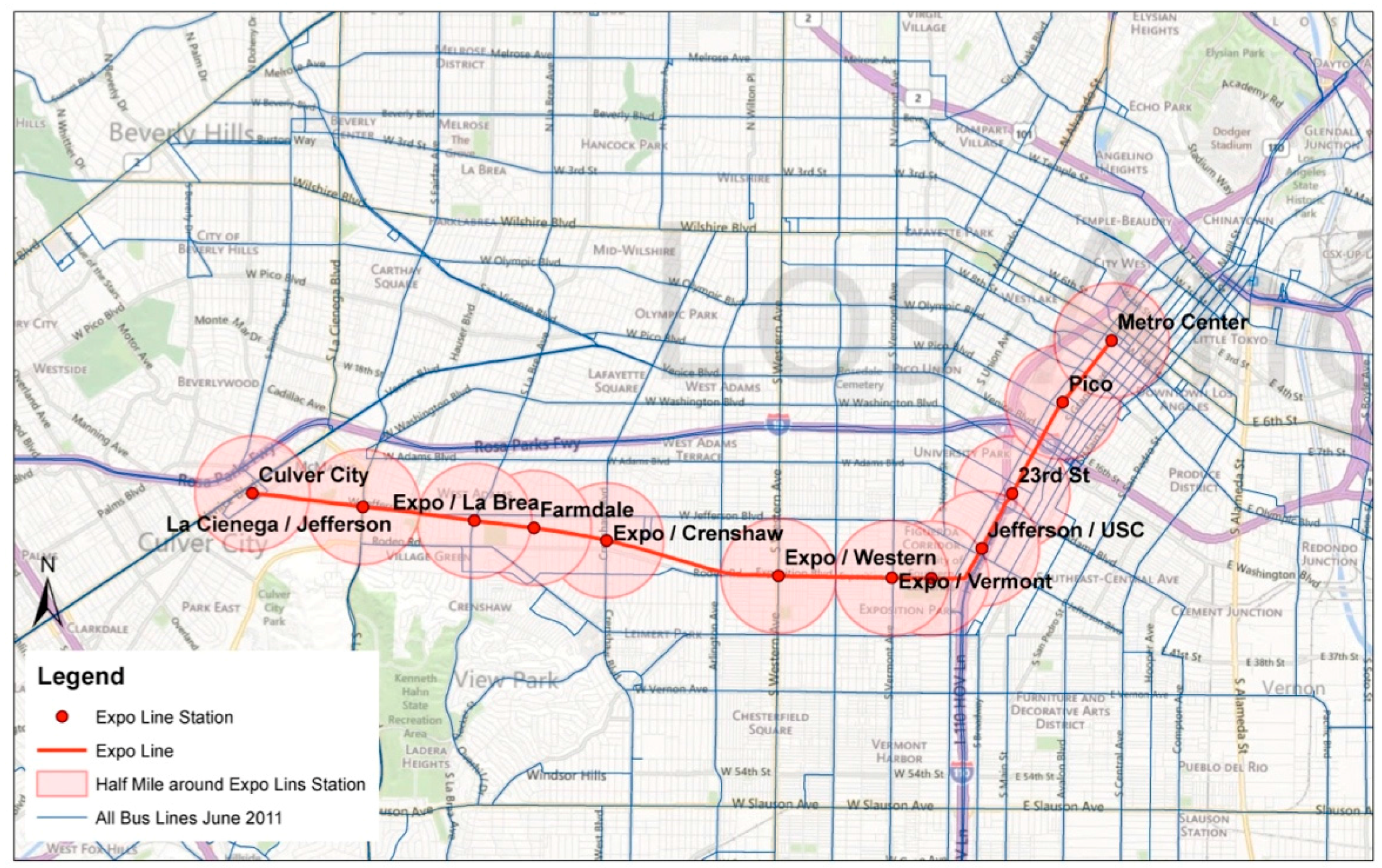
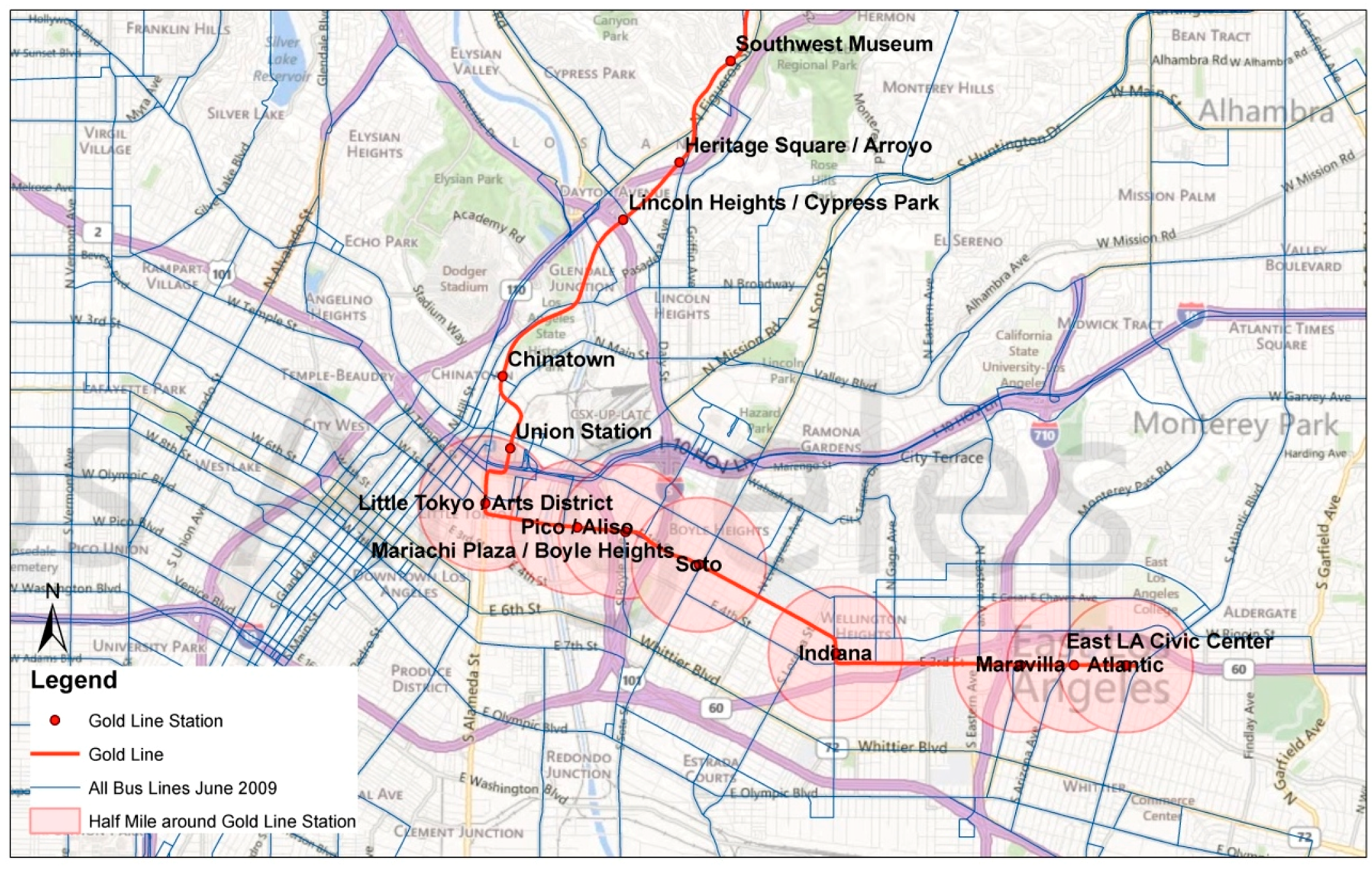
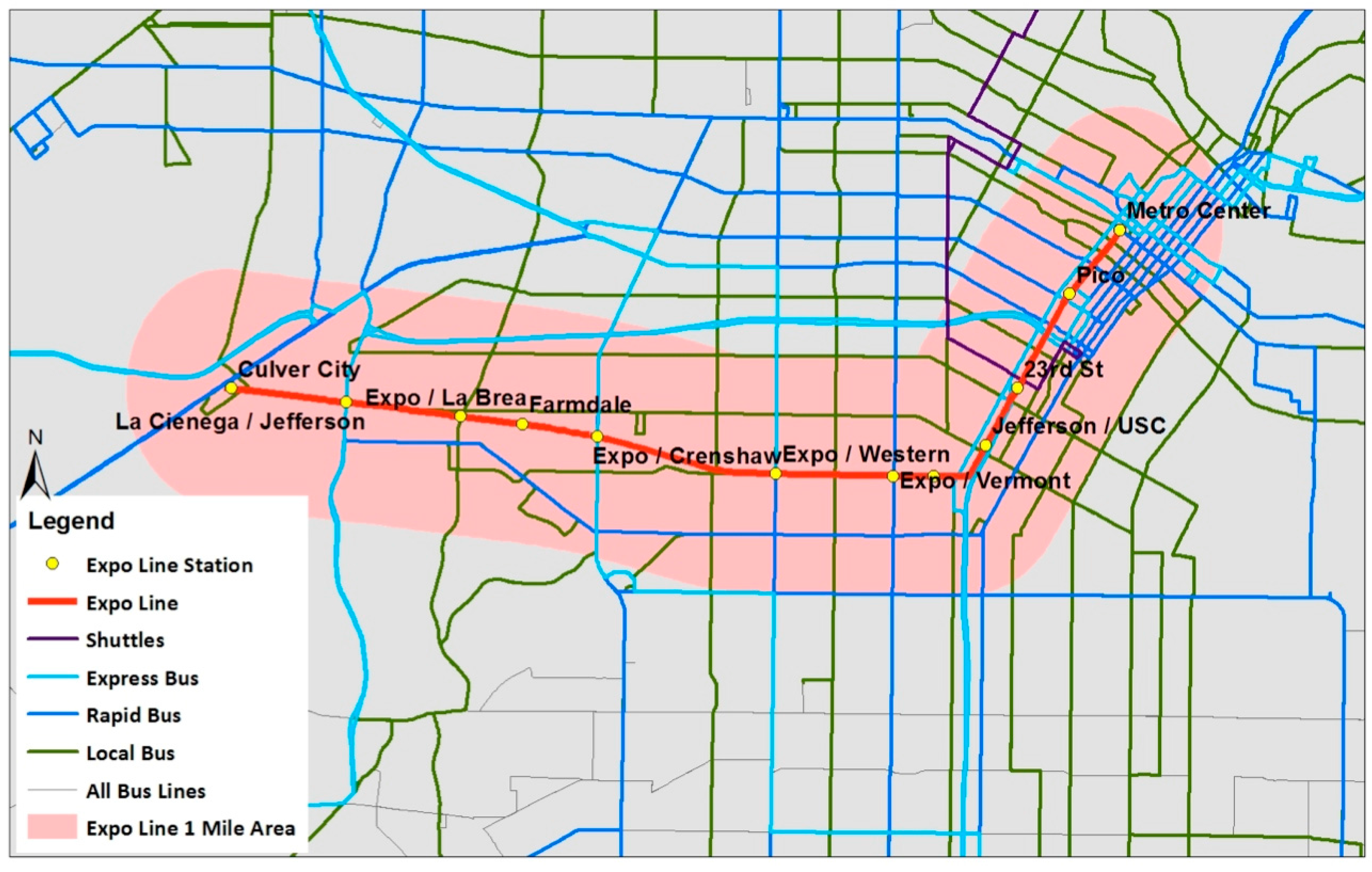
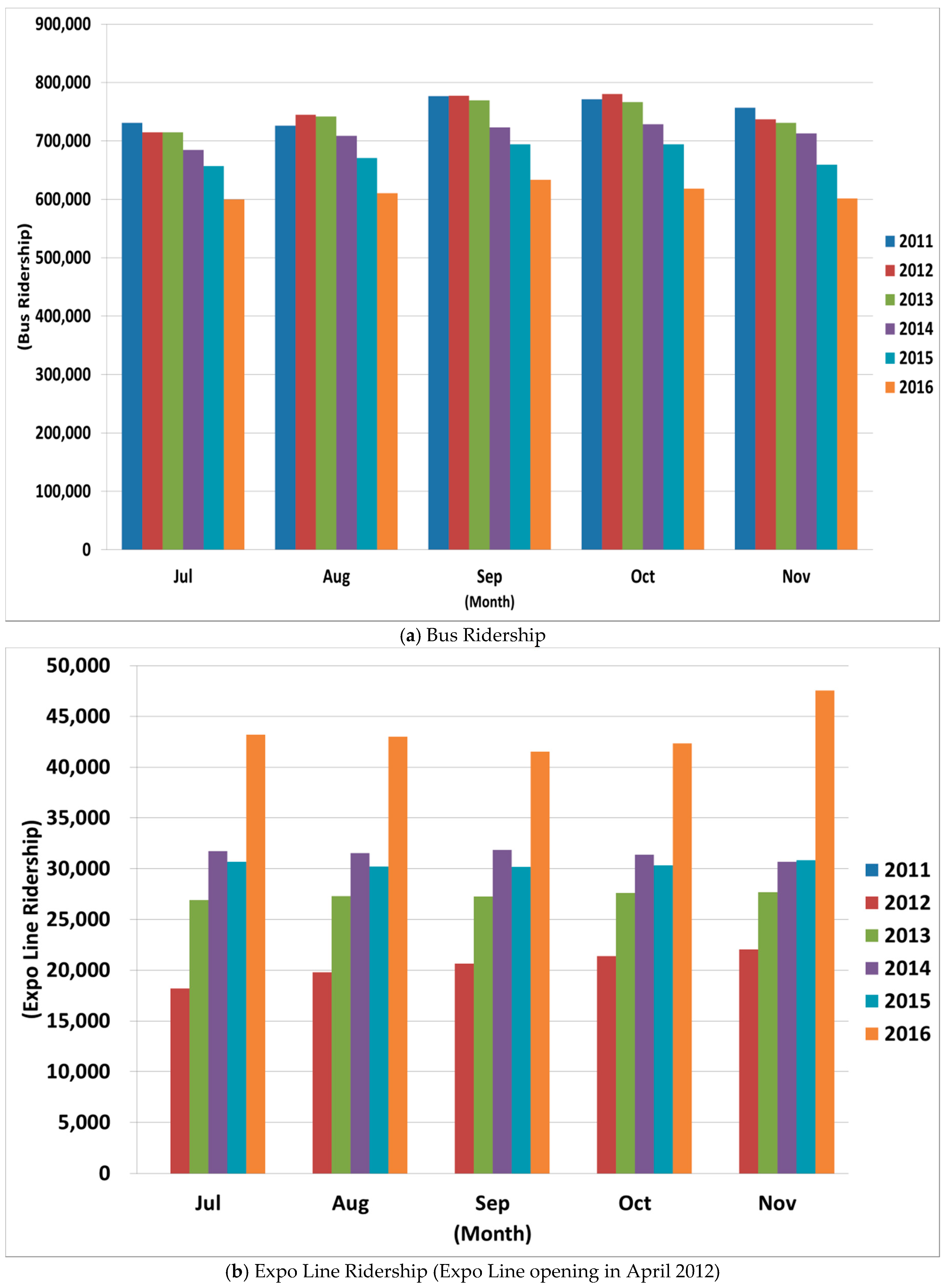
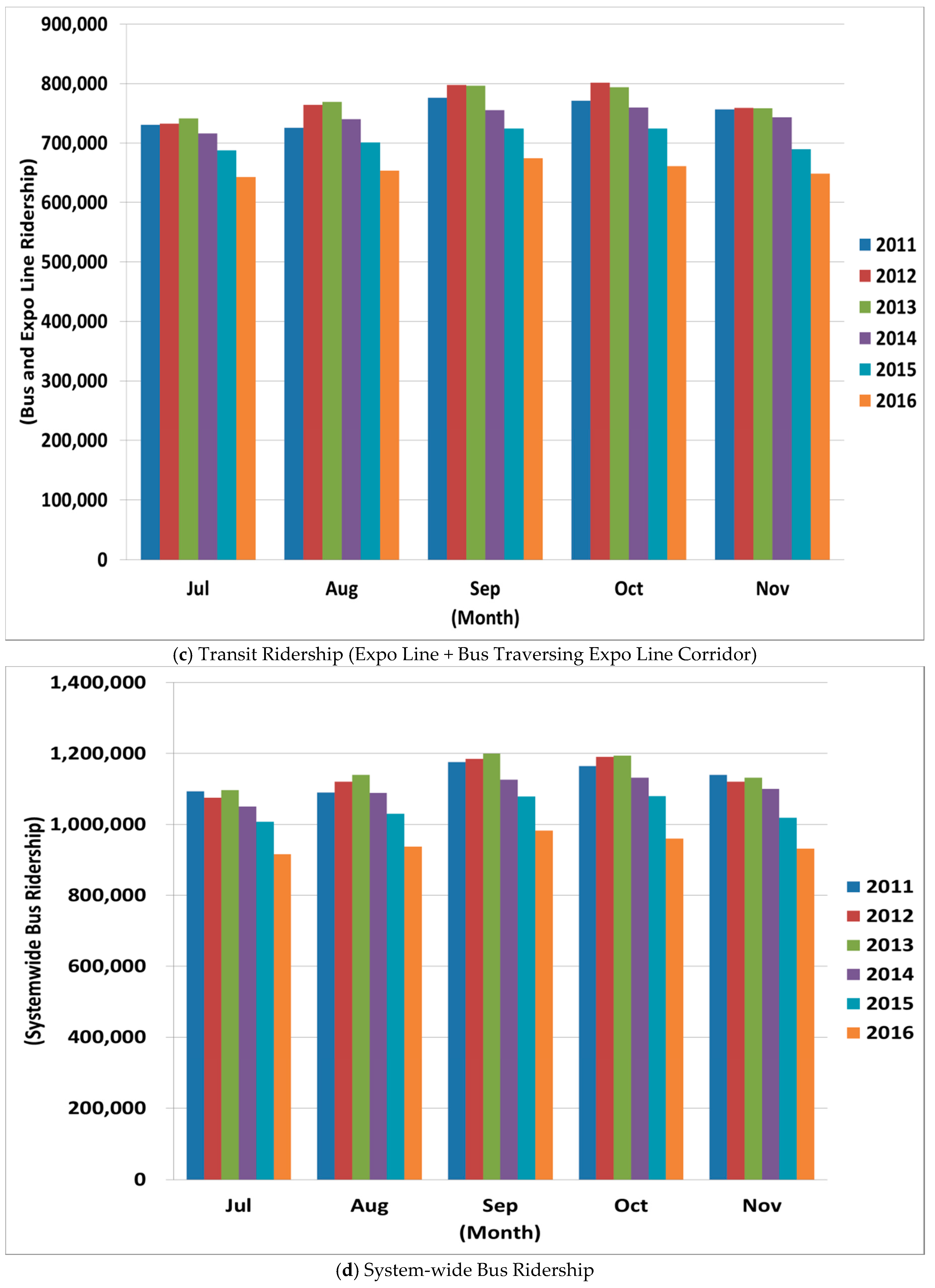
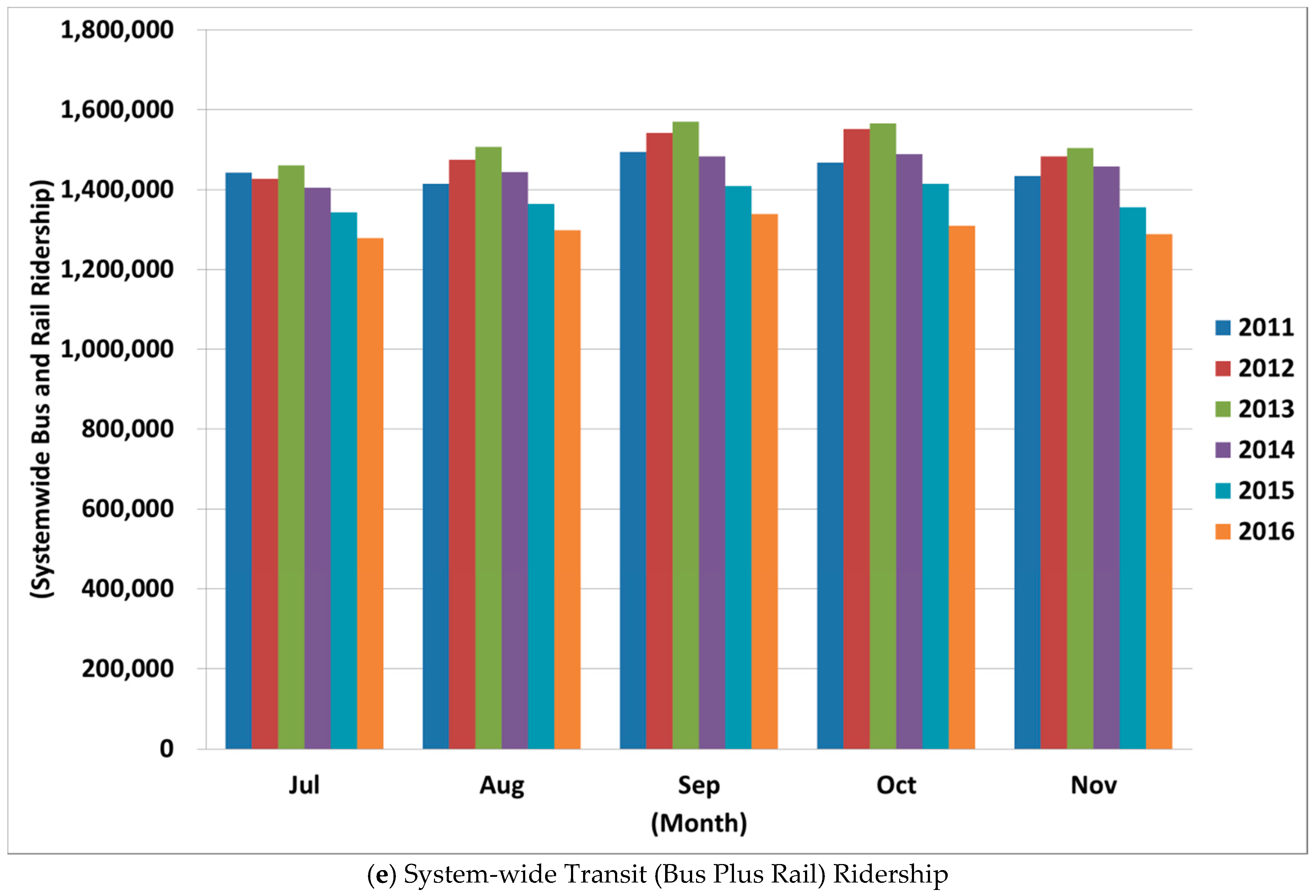

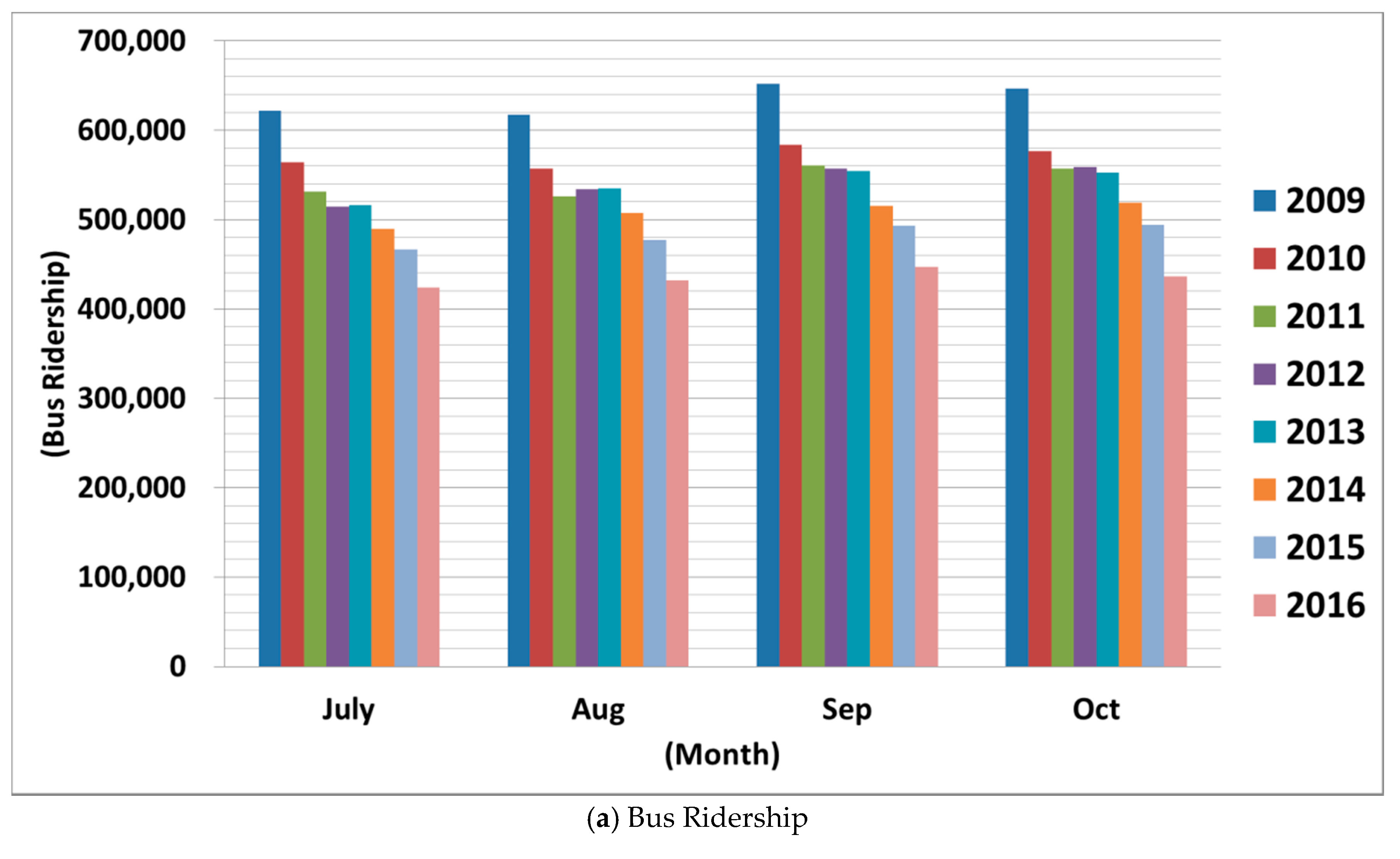

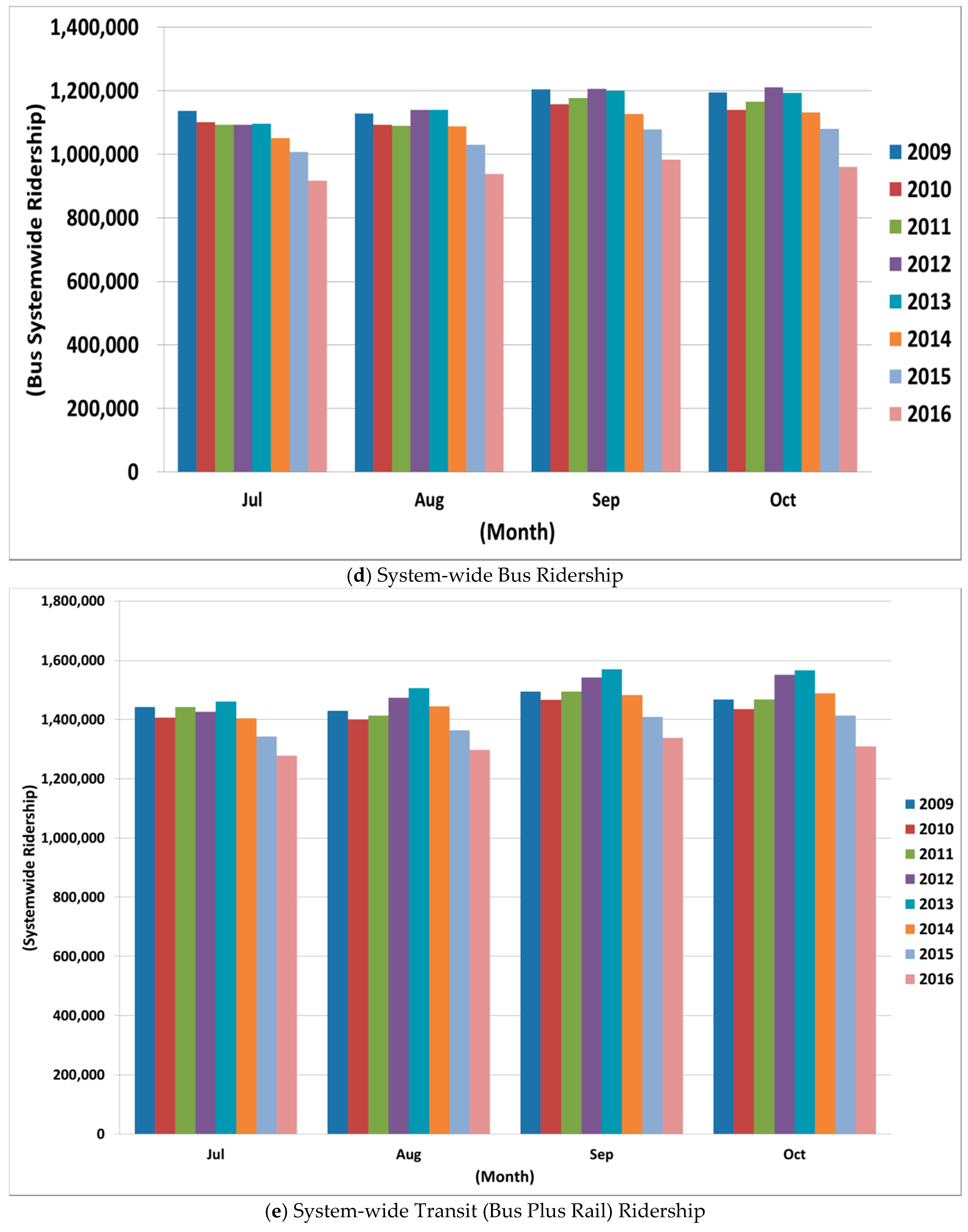
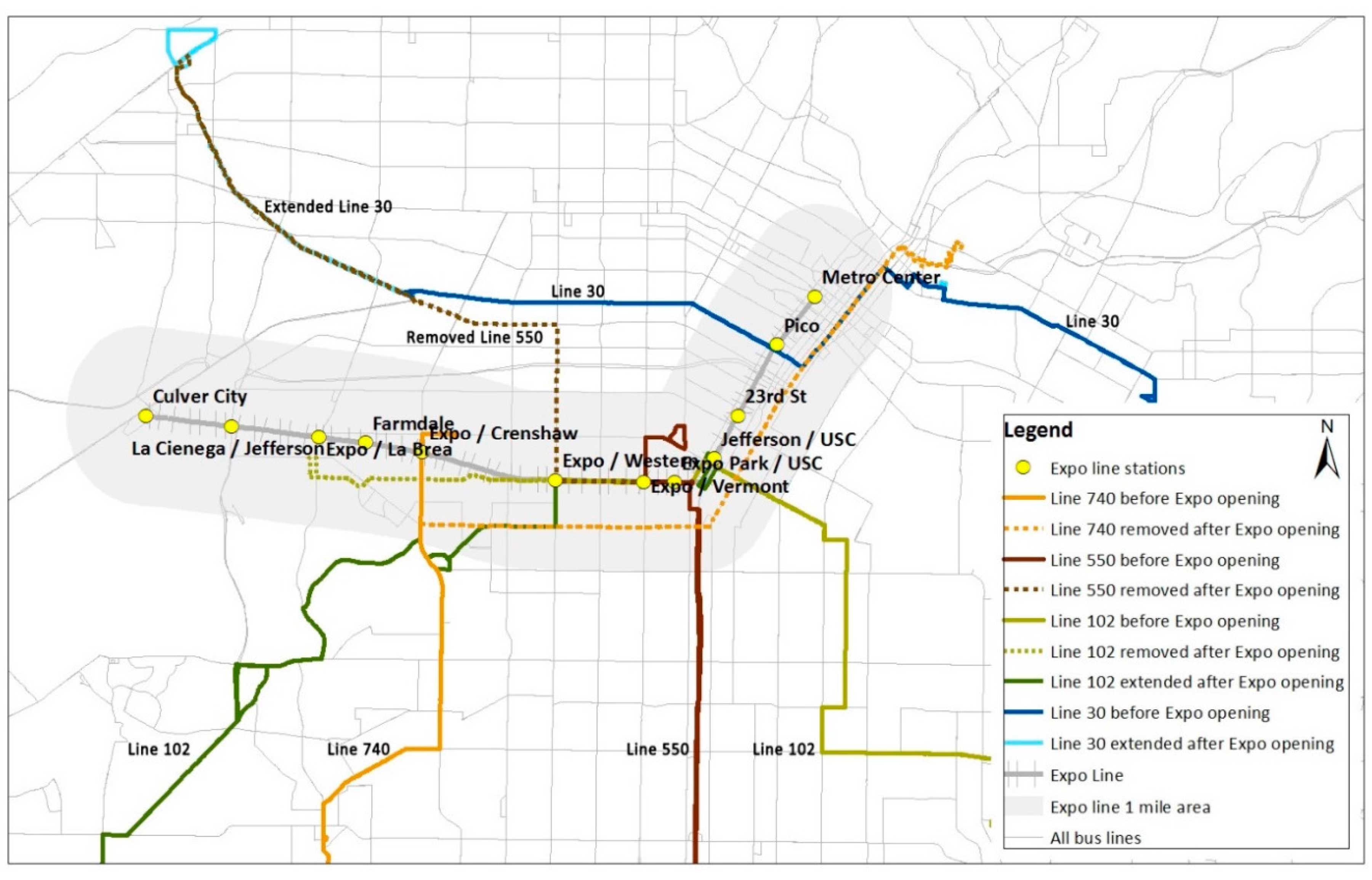
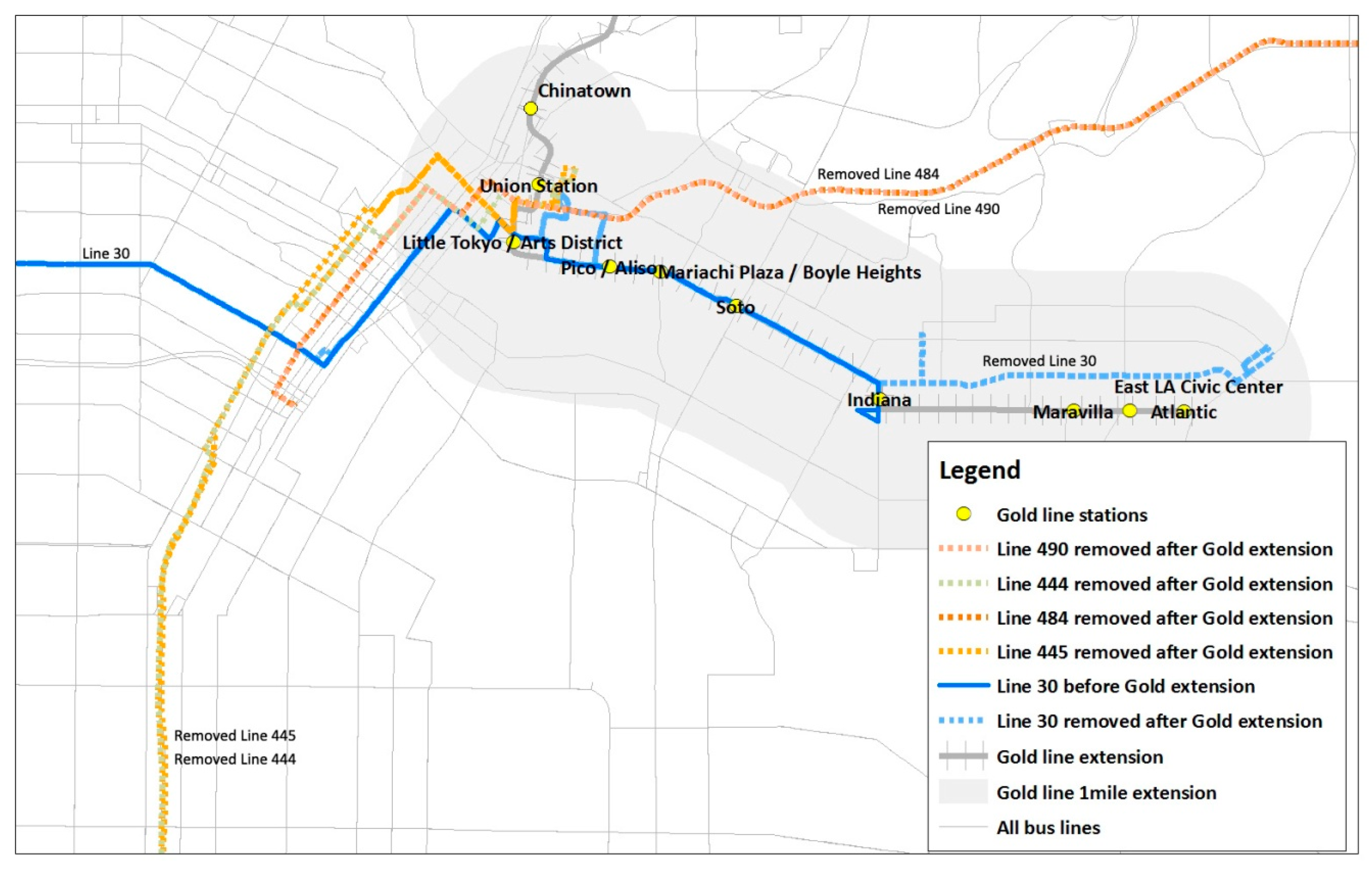
| Expo Line Corridor | System-Wide | ||||||||||
|---|---|---|---|---|---|---|---|---|---|---|---|
| Bus | Expo Line | Transit | Bus | Transit | |||||||
| Average b Ridership | Change (∆) | Average Ridership | Change (∆) | Average Ridership | Change (∆) | Average Ridership | Change (∆) | Average Ridership | Change (∆) | ||
| 2011 | Boarding a | 752,175 | -- | -- | -- | 752,175 | -- | 1,133,182 | -- | 1,450,971 | -- |
| 2012 | Boarding | 750,583 | −1592 (−0.2%) | 20,412 | -- | 770,996 | 18,821 (2.5%) | 1,138,479 | 5297 (0.5%) | 1,495,501 | 44,530 (3.0%) |
| 2013 | Boarding | 744,623 | −5960 (−0.8%) | 27,348 | 6936 (34.0%) | 771,971 | 975 (0.1%) | 1,152,534 | 14,055 (1.2%) | 1,521,456 | 25,955 (1.7%) |
| 2014 | Boarding | 711,392 | −33,231 (−4.5%) | 31,430 | 4082 (14.9%) | 742,822 | −29,149 (−3.8%) | 1,099,831 | −52,703 (−4.6%) | 1,455,822 | −65,634 (−4.3%) |
| 2015 | Boarding | 674,941 | −36,451 (−5.1%) | 30,443 | −987 (−3.1%) | 705,384 | −37,438 (−5.0%) | 1,043,255 | −56,576 (−5.1%) | 1,377,239 | −78,583 (−5.4%) |
| 2016 | Boarding | 612,568 | −62,373 (−9.2%) | 43,524 | 13,081 (43.0%) | 656,092 | −49,292 (−7.0%) | 945,807 | −97,448 (−9.3%) | 1,302,465 | −74,774 (−5.4%) |
| 2011–2016 | Total Change (∆) | −139,607 (−18.6%) | 43,524 (-) | −96,083 (−12.8%) | −187,375 (−16.5%) | −148,506 (−10.2%) | |||||
| Extended Gold Line Corridor | System-Wide | ||||||||||
|---|---|---|---|---|---|---|---|---|---|---|---|
| Bus | Gold Line | Transit | Bus | Transit | |||||||
| Average b Ridership | Change (∆) | Average Ridership | Change (∆) | Average Ridership | Change (∆) | Average Ridership | Change (∆) | Average Ridership | Change (∆) | ||
| 2009 | Boarding a | 634,711 | -- | 22,260 | -- | 656,970 | -- | 1,166,340 | -- | 1,458,882 | -- |
| 2010 | Boarding | 570,341 | −64,370 (−10.1%) | 34,905 | 12,645 (56.8%) | 605,246 | −51,724 (−7.9%) | 1,122,758 | −43,582 (−3.7%) | 1,427,349 | −31,533 (−2.2%) |
| 2011 | Boarding | 543,794 | −26,547 (−4.7%) | 39,305 | 4400 (12.6%) | 583,099 | −22,147 (−3.7%) | 1,131,160 | 8402 (0.7%) | 1,455,116 | 22,767 (1.9%) |
| 2012 | Boarding | 540,912 | −2882 (−0.5%) | 43,056 | 3751 (9.5%) | 583,968 | 869 (0.1%) | 1,162,986 | 31,826 (2.8%) | 1,498,741 | 43,625 (3.0%) |
| 2013 | Boarding | 539,408 | −1504 (−0.3%) | 44,254 | 1198 (2.8%) | 583,661 | −307 (−0.1%) | 1,157,626 | −5360 (−0.5%) | 1,525,836 | 27,095 (1.8%) |
| 2014 | Boarding | 507,819 | −31,589 (−5.9%) | 43,692 | −562 (−1.3%) | 551,511 | −32,150 (−5.5%) | 1,099,563 | −58,063 (−5.0%) | 1,455,459 | −70,377 (−4.6%) |
| 2015 | Boarding | 482,650 | −25,169 (−5.0%) | 44,739 | 1047 (2.4%) | 527,338 | −24,123 (−4.4%) | 1,049,210 | −50,353 (−4.6%) | 1,382,515 | −72,944 (−5.0%) |
| 2016 | Boarding | 434,930 | −47,720 (−9.9%) | 51,248 | 6509 (14.5%) | 486,178 | −41,210 (−7.8%) | 949,226 | −99,984 (−9.5%) | 1,306,117 | −76,398 (−5.5%) |
| 2009–2016 | Total Change (∆) | −199,781 (−31.5%) | 28,988 (130.2%) | −170,792 (−26.0%) | −217,114 (−18.6%) | −152,765 (−10.5%) | |||||
| Date | AM Peak | Base | PM Peak | Owl | Total | ||||||
|---|---|---|---|---|---|---|---|---|---|---|---|
| Runs | Percent Change 2011–2012 | Runs | Percent Change 2011–2012 | Runs | Percent Change 2011–2012 | Runs | Percent Change 2011–2012 | Runs | Percent Change 2011–2012 | ||
| System-Wide a | June 2011 | 1847 | 0.1% | 1008 | 0.6% | 1940 | −2.2% | 60 | −1.7% | 4855 | −0.8% |
| June 2012 | 1848 | 1014 | 1897 | 59 | 4818 | ||||||
| Expo Line Area b | June 2011 | 1188 | −1.6% | 647 | 1.9% | 1223 | −2.2% | 51 | −2.0% | 3109 | −1.1% |
| June 2012 | 1169 | 659 | 1196 | 50 | 3074 | ||||||
| Date | Vehicle Hours | Vehicle Miles | |||
|---|---|---|---|---|---|
| Revenue | Percent Change 2011–2012 | Revenue | Percent Change 2011–2012 | ||
| System-Wide a | June 2011 | 19,690.0 | −0.1% | 220,372.8 | −0.9% |
| June 2012 | 19,677.6 | 218,475.4 | |||
| Expo Line Area b | June 2011 | 12,751.4 | −0.3% | 137,363.5 | −1.5% |
| June 2012 | 12,709.3 | 135,356.1 | |||
| Date | AM Peak | Base | PM Peak | Owl | Total | ||||||
|---|---|---|---|---|---|---|---|---|---|---|---|
| Runs | Percent Change 2009–2010 | Runs | Percent Change 2009–2010 | Runs | Percent Change 2009–2010 | Runs | Percent Change 2009–2010 | Runs | Percent Change 2009–2010 | ||
| System-Wide a | June 2009 | 2206 | −5.4% | 1125 | −6.0% | 2333 | −3.7% | 61 | −3.3% | 5725 | −4.8% |
| June 2010 | 2087 | 1057 | 2247 | 59 | 5450 | ||||||
| Gold Line Area b | June 2009 | 1214 | −14.3% | 636 | −10.8% | 1285 | −13.0% | 45 | −4.4% | 3180 | −13.0% |
| June 2010 | 1040 | 567 | 1118 | 43 | 2768 | ||||||
| Date | Vehicle Hours | Vehicle Miles | |||
|---|---|---|---|---|---|
| Revenue | Percent Change 2009–2010 | Revenue | Percent Change 2009–2010 | ||
| System-Wide a | June 2009 | 22,138.2 | 5.5% | 257,463.4 | −6.1% |
| June 2010 | 20,916.1 | 241,663.1 | |||
| Gold Line Area b | June 2009 | 12,668.1 | −12.9% | 142,768.3 | −15.9% |
| June 2010 | 11,035.0 | 120,070.6 | |||
| Bus # | Date | Number of Runs for the Route (2011–2012) | Ridership Change | ||||
|---|---|---|---|---|---|---|---|
| AM Peak | Base | PM Peak | Owl | Average Difference | % Difference | ||
| # 30 | June 2011 | 15 | 10 | 19 | 2 | 5791 | 44.4% |
| June 2012 | 23 | 19 | 25 | 2 | |||
| # 102 | June 2011 | 3 | 3 | 3 | 860 | 52.7% | |
| June 2012 | 6 | 6 | 6 | ||||
| # 550 | June 2011 | 7 | 5 | 9 | −1527 | −47.4% | |
| June 2012 | 5 | 2 | 5 | ||||
| # 740 | June 2011 | 17 | 7 | 16 | −3760 | −48.1% | |
| June 2012 | 12 | 6 | 13 | ||||
| Bus # | Date | Number of Runs for the Route (2009–2010) | Ridership Change | ||||
|---|---|---|---|---|---|---|---|
| AM Peak | Base | PM Peak | Owl | Average Difference | % Difference | ||
| # 30 | June 2009 | 20 | 13 | 24 | 2 | −3555 | −21.5% |
| June 2010 | 16 | 10 | 19 | 2 | |||
| # 444 | June 2009 | 16 | 4 | 11 | - | −3010 | - |
| June 2010 | - | - | - | - | |||
| # 445 | June 2009 | 7 | 3 | 8 | - | −142 | - |
| June 2010 | - | - | - | - | |||
| # 484 | June 2009 | 26 | 10 | 25 | - | −7324 | -- |
| June 2010 | - | - | - | - | |||
| # 490 | June 2009 | 23 | 6 | 24 | - | −6010 | -- |
| June 2010 | - | - | - | - | |||
© 2017 by the authors. Licensee MDPI, Basel, Switzerland. This article is an open access article distributed under the terms and conditions of the Creative Commons Attribution (CC BY) license (http://creativecommons.org/licenses/by/4.0/).
Share and Cite
Lee, J.; Boarnet, M.; Houston, D.; Nixon, H.; Spears, S. Changes in Service and Associated Ridership Impacts near a New Light Rail Transit Line. Sustainability 2017, 9, 1827. https://doi.org/10.3390/su9101827
Lee J, Boarnet M, Houston D, Nixon H, Spears S. Changes in Service and Associated Ridership Impacts near a New Light Rail Transit Line. Sustainability. 2017; 9(10):1827. https://doi.org/10.3390/su9101827
Chicago/Turabian StyleLee, Jeongwoo, Marlon Boarnet, Douglas Houston, Hilary Nixon, and Steven Spears. 2017. "Changes in Service and Associated Ridership Impacts near a New Light Rail Transit Line" Sustainability 9, no. 10: 1827. https://doi.org/10.3390/su9101827
APA StyleLee, J., Boarnet, M., Houston, D., Nixon, H., & Spears, S. (2017). Changes in Service and Associated Ridership Impacts near a New Light Rail Transit Line. Sustainability, 9(10), 1827. https://doi.org/10.3390/su9101827




